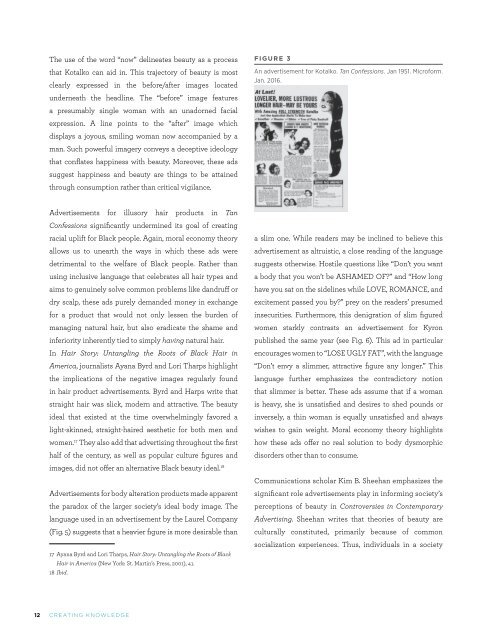UNDERGRADUATE
Ycb5305N2JX
Ycb5305N2JX
Create successful ePaper yourself
Turn your PDF publications into a flip-book with our unique Google optimized e-Paper software.
FIGURE 4<br />
An advertisement for G&T Real Human Hair. Tan Confessions. Mar<br />
1951. Microform. Jan. 2016.<br />
FIGURE 5<br />
An advertisement by Laurel Company. Tan Confessions. Jan 1951.<br />
Microform. Jan. 2016.<br />
posses shared cultural ideals. 19 Had Tan Confessions<br />
sought to publish, say, medicinal ads that combat the<br />
body’s internal problems rather than external, it would<br />
have potentially succeeded in its goal of ensuring the wellbeing<br />
of Black people.<br />
Conclusion<br />
The first two issues of Tan Confessions published<br />
in November and December of 1950 contained no<br />
advertisements. As time progressed, however, ads for<br />
beauty products, household items, and expensive jewelry<br />
proliferated throughout the magazine. What were once<br />
quarter-page advertisements eventually evolved into<br />
full-page spreads, constituting almost one-third of the<br />
entire publication. Such a rise in advertisements in Tan<br />
Confessions reflected the larger society’s accepting<br />
attitude toward consumerism.<br />
While I have pointed out the multiple ways in which Tan<br />
Confessions failed in its goal of racial uplift among Black<br />
people, it is worthwhile to mention how racial uplift was<br />
practiced before the period of economic prosperity during<br />
the 50s. bell hooks recounts the shared values associated<br />
with Blacks in the south during this time:<br />
A child of the fifties in that part of the American south<br />
that was always seen as culturally backward, I was raised<br />
in a world where racial uplift was the norm. Like their<br />
nineteenth-century ancestors, our working-class parents<br />
believed that if we wanted freedom we had to be worthy of<br />
it, that we had to educate ourselves, work hard, be people<br />
of integrity. Racial uplift through self-help meant not just<br />
that we should confront racism, we should become fully<br />
cultured holistic individuals. 20<br />
Unfortunately, the value placed on integrity and<br />
education was replaced with hedonistic consumption<br />
as Tan Confessions so clearly emphasized through its<br />
advertisements. Useful strategies to move away from the<br />
destructive culture of Black consumerism involve rejecting<br />
negative images, languages, and representation of Blacks<br />
in advertisements and mass media. Again, hooks describes<br />
the formation of this damaging culture of consumerism:<br />
When many black Americans measured their potential for<br />
freedom, success, and well-being against the standard set<br />
by white middle-class culture and the burgeoning culture<br />
of class privilege that prioritized consumerism and greed,<br />
they saw ethical and moral values as impediments. 21<br />
When the compulsion to consume is suppressed, a re-<br />
19 Kim B. Sheehan, Controversies in Contemporary Advertising (United<br />
Kingdom: Sage Publications, 2004), 95.<br />
20 hooks, Rock My Soul: Black People and Self-Esteem, 11.<br />
21 Ibid., 57<br />
DEPAUL UNIVERSITY<br />
13


